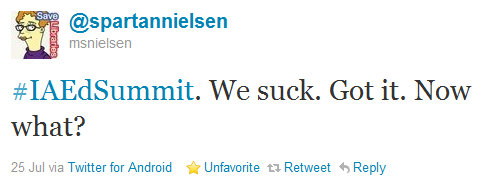Reflections on the Iowa Education Summit

I’ve spent the last two days at the Iowa Education Summit. Now that it’s over, I have a multitude of thoughts and observations swirling around in my head. Here are eight…
1. Politics over substance?
From the anti-Governor Christie flyers distributed at the entrances to the invited guests who appeared to be there for political reasons rather than their possible contributions to Iowa education, there was a great deal of political theater at the Summit. I’ll leave it at that. You can decide for yourself who was invited for what reasons.
On a related note, many participants left the Summit saying that they didn’t learn much that was new and that they wished that there was more discussion about solutions rather than repeated reminders of how much Iowa education sucks. Personally, I enjoyed hearing from the various experts that were invited. There was a lot of brainpower at the Summit and I enjoyed hearing perspectives from other places during our two days together. We’ll need equal brainpower, however, to sift through all of the commentary and determine what to do next in terms of policy and implementation.
2. The ascendance of Twitter
The backchannel on Twitter was phenomenal. I have the very naive wish that Iowa policymakers would spend some time going through the tweets. The backchannel conversation was witty, passionate, insightful, both challenging AND supportive, and, most of all, real. Whatever political points were being attempted on stage were dissected in depth and filtered through the honest reality of learning, teaching, and living in Iowa. The very best barometers of how crowd members were receiving the intended message(s) were the tweets at #iaedsummit.
The Summit was the first event I’ve attended in Iowa where the Twitter backchannel was so robust that I had trouble keeping up. I don’t know how many of the 1,600 attendees actually were on Twitter, but the sheer volume of tweets was astounding. I know several people who signed up for Twitter there at the Summit so that they wouldn’t miss the side discussion.
3. ‘Sit and get’ and clickers do not a conversation make
There was extremely limited opportunity for interaction and dialogue at the Summit. Thank goodness for the Twitter stream. The Summit consisted primarily of smart ‘experts,’ either individually or on panels, talking down at the audience (literally down, from a raised dais). Occasionally we got to answer a multiple choice question using Promethean ‘clickers.’ Occasionally we got to ask a question during a breakout panel. If we were really lucky, perhaps a question we wrote on an index card would be read out loud to solicit a speaker response. This does not constitute a conversation any more than a teacher lecture with a few clicker questions and a brief opportunity for student questions constitutes a classroom discussion.
The stated purpose of the Summit was ‘to build a consensus for how to give all [Iowa] students a world-class education.’ I don’t see how Iowans can build a consensus when we’re not allowed to talk and argue and share and collaborate. We need a different structure if we’re truly going to have a dialogue about the future of Iowa education.
4. What could have been
U.S. Secretary of Education Arne Duncan gives a good speech (and really shines during Q & A). So do current and/or past Governors Chris Christie, Jim Hunt, and our very own Terry Branstad. But the crowd favorite by far was Stanford professor Linda Darling-Hammond. In a concise, focused talk replete with research and evidence instead of political talking points, she spelled out what high-achieving nations do (and don’t do) in order to achieve high and equitable levels of student learning. Dr. Darling-Hammond was in the running for U.S. Secretary of Education. After hearing her speak, many in the crowd found themselves wishing that she had been selected.
5. NAEP or nope?
One of the driving statistics for the Summit – which was cited repeatedly – was Iowa’s alarming drop in national rank on the National Assessment of Educational Progress (NAEP). I confess that I found it humorous when Dr. Darling-Hammond began discussing higher-order versus lower-level thinking skills. To illustrate her point, she showed an example of a shoddy multiple-choice assessment question for high-schoolers, which just so happened(?) to come from NAEP. Given the consistent emphasis throughout the conference by all of the presenters on the need for more students to be proficient in higher-order thinking skills, I know I wasn’t the only one in the audience wondering why we’re so concerned about results on an assessment rife with lower-level items.
Secretary Duncan and other speakers highlighted federal and other initiatives that are aimed at creating assessments that get at higher-level student work. So should we really care about Iowa’s rank on NAEP since most of the assessment doesn’t get at what we really need to get at?
6. Technology was largely absent
Although there were a few quick shout-outs to the power of technology to transform student learning, there weren’t many specifics given. Secretary Duncan, for example, cited the power of technology to better ‘deliver information’ [emphasis added] during his Q & A time (and mentioned technology not a whit during his main speech). For those of us who are used to talking about the power and potential of digital technologies to empower student voice and engagement, facilitate authentic work, and connect learners to the global information commons and its participants (just to name a few affordances), the lack of specificity was dismaying. I suspect that the very basic treatment of technology stemmed from folks’ fairly basic understandings of what is possible these days. An exception was Max Phillips, who serves on the Iowa State Board of Education and who is thinking big. Very big. I wish we had more policymakers in Iowa who were ready to join him.
As I said on Monday, it’s time for us to get serious about school technology in this state (we can start by having wireless Internet access at every public Department of Education function like this one).
7. We’re ready for something different
Iowa is ready for something different. It’s ready for the things that Dr. Darling-Hammond described. If you look at what high-achieving nations actually do to achieve their learning outcomes – the outcomes that Iowa says it also wants to achieve – their efforts are not in the domains of:
Instead, they are:
The panel members generally were closer to what Dr. Darling-Hammond shared with us. The Summit’s main speakers, however, placed great emphasis on the first four items. Which brings me to my last thought…
8. Genuine dialogue or political cover?
The great unknown is whether Governor Branstad and the Iowa Department of Education truly intended the Summit to initiate a statewide dialogue about what effective learning, teaching, and schooling should look like in the state or whether the Summit was just to give cover for implementation of an already-determined political / educational agenda. Only time will tell. Right now I’m willing to take Iowa Education Director Dr. Jason Glass (whom I like more and more every time I interact with him) at his word when he says that he wants us to build the solution together. He’s not the political boss, however, and there was a lot of cynicism regarding this issue in the crowd. If we see policy proposals that heavily emphasize items 1–4 above and deemphasize items 5–11, for example, those skeptics will feel vindicated.
Despite what may seem like an overly-critical tone for this post, I enjoyed the Summit and am glad I attended and participated. Like many of the other speakers there, I believe that we have an opportunity to do – and already are doing – great things in Iowa education. In some areas, we have promising initiatives (like the Authentic Intellectual Work, 1:1 laptop, VREP, and instructional rounds movements) that just need scaling up. In other areas, we have much more to do.
Let the real work begin.
Image credit:spartannielsen




